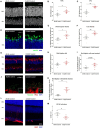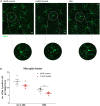Coenzyme Q10 eyedrops conjugated with vitamin E TPGS alleviate neurodegeneration and mitochondrial dysfunction in the diabetic mouse retina
- PMID: 38863499
- PMCID: PMC11165046
- DOI: 10.3389/fncel.2024.1404987
Coenzyme Q10 eyedrops conjugated with vitamin E TPGS alleviate neurodegeneration and mitochondrial dysfunction in the diabetic mouse retina
Abstract
Diabetic retinopathy (DR) is a leading cause of blindness and vision impairment worldwide and represents one of the most common complications among diabetic patients. Current treatment modalities for DR, including laser photocoagulation, intravitreal injection of corticosteroid, and anti-vascular endothelial growth factor (VEGF) agents, target primarily vascular lesions. However, these approaches are invasive and have several limitations, such as potential loss of visual function, retinal scars and cataract formation, and increased risk of ocular hypertension, vitreous hemorrhage, retinal detachment, and intraocular inflammation. Recent studies have suggested mitochondrial dysfunction as a pivotal factor leading to both the vascular and neural damage in DR. Given that Coenzyme Q10 (CoQ10) is a proven mitochondrial stabilizer with antioxidative properties, this study investigated the effect of CoQ10 eyedrops [in conjunction with vitamin E d-α-tocopheryl poly(ethylene glycol) 1000 succinate (TPGS)] on DR-induced neurodegeneration using a type 2 diabetes mouse model (C57BLKsJ-db/db mice). Utilizing a comprehensive electroretinography protocol, supported by immunohistochemistry, our results revealed that topical application of CoQ10 eyedrops conjugated with vitamin E TPGS produced a neuroprotective effect against diabetic-induced neurodegeneration by preserving the function and histology of various retinal neural cell types. Compared to the control group, mice treated with CoQ10 exhibited thicker outer and inner nuclear layers, higher densities of photoreceptor, cone cell, and rod-bipolar cell dendritic boutons, and reduced glial reactivity and microglial cell density. Additionally, the CoQ10 treatment significantly alleviated retinal levels of MMP-9 and enhanced mitochondrial function. These findings provide further insight into the role of mitochondrial dysfunction in the development of DR and suggest CoQ10 eyedrops, conjugated with vitamin E TPGS, as a potential complementary therapy for DR-related neuropathy.
Keywords: Coenzyme Q10; diabetic retinopathy; electroretinography; mitochondrial dysfunction; neurodegeneration.
Copyright © 2024 Lam, Zuo, Chan, Leung, Abokyi, Catral and Tse.
Conflict of interest statement
The authors declare that the research was conducted in the absence of any commercial or financial relationships that could be construed as a potential conflict of interest.
Figures






Similar articles
-
Functional and structural changes in the neuroretina are accompanied by mitochondrial dysfunction in a type 2 diabetic mouse model.Eye Vis (Lond). 2023 Sep 1;10(1):37. doi: 10.1186/s40662-023-00353-2. Eye Vis (Lond). 2023. PMID: 37653465 Free PMC article.
-
Topical Coenzyme Q10 demonstrates mitochondrial-mediated neuroprotection in a rodent model of ocular hypertension.Mitochondrion. 2017 Sep;36:114-123. doi: 10.1016/j.mito.2017.05.010. Epub 2017 May 24. Mitochondrion. 2017. PMID: 28549843 Free PMC article.
-
Trolox aids coenzyme Q10 in neuroprotection against NMDA induced damage via upregulation of VEGF in rat model of glutamate excitotoxicity.Exp Eye Res. 2024 Jan;238:109740. doi: 10.1016/j.exer.2023.109740. Epub 2023 Dec 4. Exp Eye Res. 2024. PMID: 38056553
-
[Cell biology of intraocular vascular diseases].Nippon Ganka Gakkai Zasshi. 1999 Dec;103(12):923-47. Nippon Ganka Gakkai Zasshi. 1999. PMID: 10643294 Review. Japanese.
-
Intravitreal Anti-Vascular Endothelial Growth Factor Agents for the Treatment of Diabetic Retinopathy: A Review of the Literature.Pharmaceutics. 2021 Jul 26;13(8):1137. doi: 10.3390/pharmaceutics13081137. Pharmaceutics. 2021. PMID: 34452097 Free PMC article. Review.
Cited by
-
The Role of Diet and Oral Supplementation for the Management of Diabetic Retinopathy and Diabetic Macular Edema: A Narrative Review.Biomed Res Int. 2025 Feb 24;2025:6654976. doi: 10.1155/bmri/6654976. eCollection 2025. Biomed Res Int. 2025. PMID: 40041571 Free PMC article. Review.
-
Topical Ocular Drug Delivery: The Impact of Permeation Enhancers.Pharmaceutics. 2025 Mar 31;17(4):447. doi: 10.3390/pharmaceutics17040447. Pharmaceutics. 2025. PMID: 40284442 Free PMC article. Review.
-
SMOX Inhibition Preserved Visual Acuity, Contrast Sensitivity, and Retinal Function and Reduced Neuro-Glial Injury in Mice During Prolonged Diabetes.Cells. 2024 Dec 12;13(24):2049. doi: 10.3390/cells13242049. Cells. 2024. PMID: 39768141 Free PMC article.
References
-
- Antonetti D. A., Barber A. J., Bronson S. K., Freeman W. M., Gardner T. W., Jefferson L. S., et al. (2006). Diabetic retinopathy. Diabetes 55 2401–2411. - PubMed
-
- Barber A. J. (2003). A new view of diabetic retinopathy: A neurodegenerative disease of the eye. Prog. Neuropsychopharmacol. Biol. Psychiatry 27 283–290. - PubMed
LinkOut - more resources
Full Text Sources
Miscellaneous

